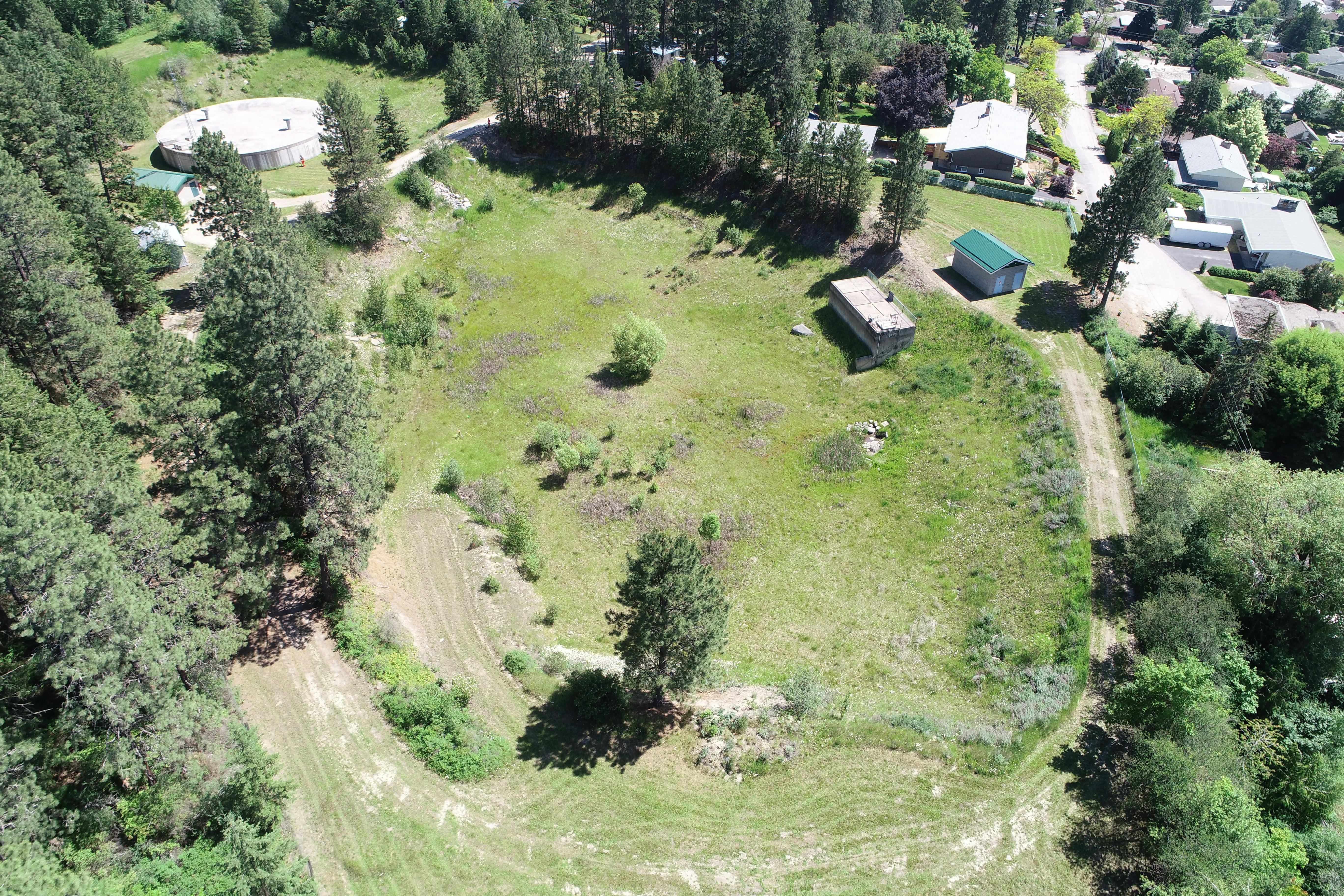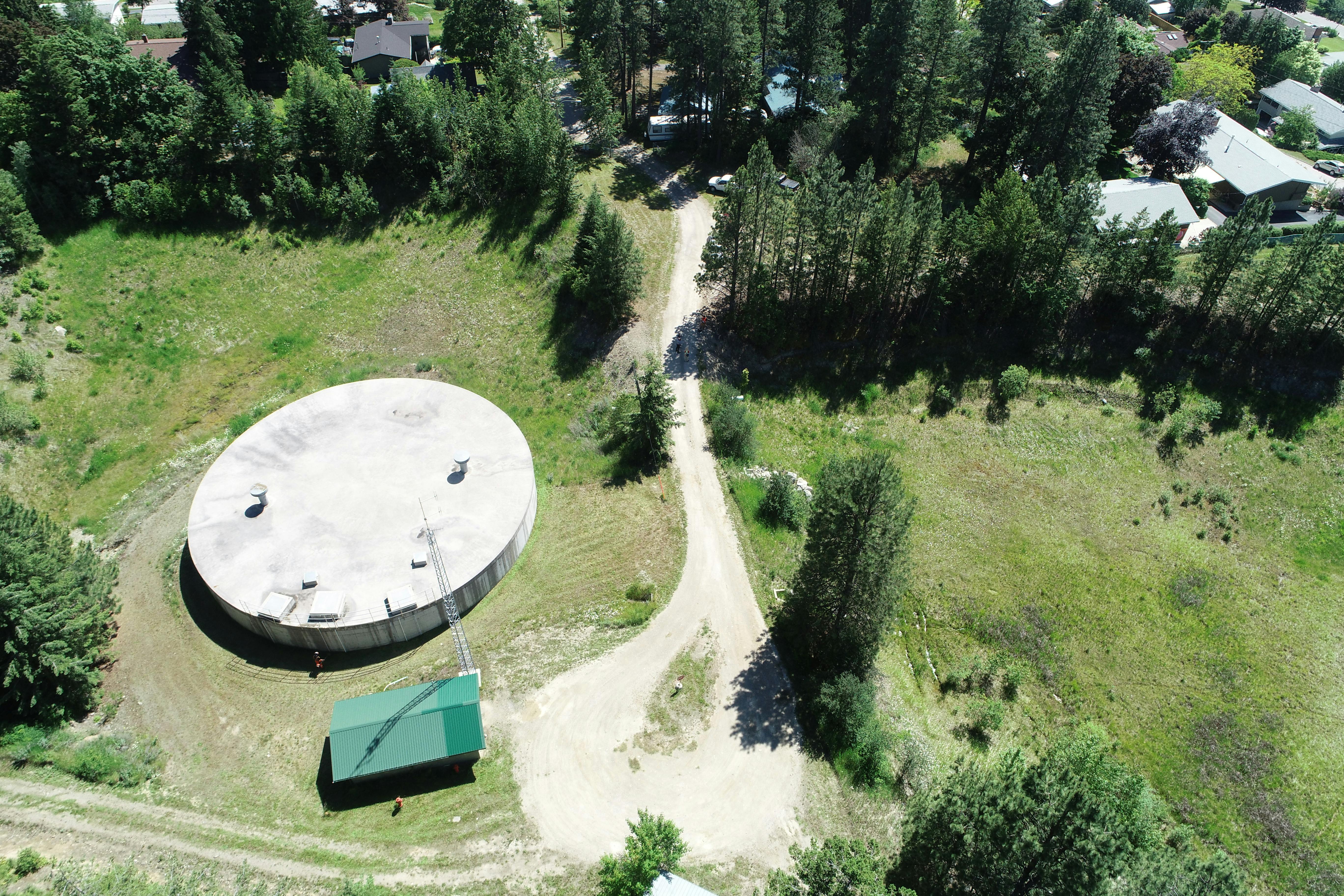Crawford Hill Reservoir Restoration and Public Open Space
Consultation has concluded
Over the coming years, the Town will work towards the implementation of the conceptual site plan. We will be researching and applying for grants, seeking partnerships with community groups, and continuing to gather feedback from community members. We will monitor the opening of this public open space and continue to be responsive to feedback as the site evolves. The plan is not set in stone, and may be adjusted based on community usage, funding opportunities, and other circumstances that arise.
Interested in project updates? Be sure to subscribe to this project.
Do you have questions, comments, or ideas? We'd love to hear from you below!
This project has been made possible through the generous funding provided in part by Creston Valley Community Forest ($75,000), Columbia Basin Trust ($75,000), and the Regional District of Central Kootenay ($40,000). Full implementation of the Conceptual Site Plan is anticipated to require additional grant funding and the formation of partnerships with community groups.
 |  |  |
Over the coming years, the Town will work towards the implementation of the conceptual site plan. We will be researching and applying for grants, seeking partnerships with community groups, and continuing to gather feedback from community members. We will monitor the opening of this public open space and continue to be responsive to feedback as the site evolves. The plan is not set in stone, and may be adjusted based on community usage, funding opportunities, and other circumstances that arise.
Interested in project updates? Be sure to subscribe to this project.
Do you have questions, comments, or ideas? We'd love to hear from you below!
This project has been made possible through the generous funding provided in part by Creston Valley Community Forest ($75,000), Columbia Basin Trust ($75,000), and the Regional District of Central Kootenay ($40,000). Full implementation of the Conceptual Site Plan is anticipated to require additional grant funding and the formation of partnerships with community groups.
 |  |  |
-
We are Open!
Share We are Open! on Facebook Share We are Open! on Twitter Share We are Open! on Linkedin Email We are Open! link
On Tuesday, October 18, 2022 at 2:00 pm, the Dwight and Rosamond Moore Community Wetland had its grand opening. Thank you to all those who attended. We hope everyone gets the opportunity to enjoy this public open space!


-
The Park has a Name!
Share The Park has a Name! on Facebook Share The Park has a Name! on Twitter Share The Park has a Name! on Linkedin Email The Park has a Name! link Mock-up of Park Entrance Sign
Mock-up of Park Entrance SignThe Crawford Hill Reservoir Restoration and Public Open Space has been named in honour of Dwight & Rosamond Moore.
Longtime residents of the Creston Valley, Dwight and Rosamond Moore are recognized for their significant contributions to the Creston Valley Wildlife Management Area. Their years of dedication to the local wetlands, wildlife, family and community are far reaching and will continue to benefit the Creston Valley for years to come.
In 1947, a far-sighted federal biologist, J.A. Munro, had surveyed the Creston Valley and had made broad suggestions for renovation of the wetlands to a productive state from their flood-scoured mudflat condition. His suggestions aligned with pressure from local and regional Rod and Gun clubs, birders, and conservationists and the BC Legislature passed an Act creating the Creston Valley Wildlife Management Area.
Dwight was recruited for a contract in November 1967 to develop a plan for the 7,000-hectare Creston Marshes.
He dedicated more than 20 years of his life to the CVWMA in which time wildlife flocked to the wetlands. The Management Area was a jewel in the crown (the words of a BC Minister of the Environment) of both federal and provincial wildlife agencies and attracted a stream of high-level Canadian and international scientists and politicians. The Wildlife Centre was a magnet for a growing number of visitors including Master’s and PhD students.
Success followed success. The CVWMA has received designations as a Ramsar site (1994), an Important Bird Area (2002), and an Important Amphibian and Reptile Area (2005).
Dwight and Rosamond’s legacy lives on as the Creston Valley Wildlife Management Area continues to plays host to close to 400 wildlife species including the endangered Northern Leopard Frogs and important aquatic plant species, many of which would not be present in the Creston Valley without the established habitat management. https://crestonwildlife.ca/
Continue to read for a detailed history
~ The Younger Years ~
Dwight’s passion for wildland, survival, wild craft and the outdoors started in his youth as a Boy Scout and Eagle Scout later becoming a Scout Leader while in University. He obtained his Bachelor’s degree from the University of Maine was heavy to wildlife studies and just as heavy to skiing. His Master’s at the U. of Massachusetts (1959) was in waterfowl management, studying what it was in different bogs and swamps that attracted waterfowl – or didn’t. The University of Utah beckoned (skiing again!) and it had a connection to the Delta Waterfowl Research Station at Delta, Manitoba, north of Portage la Prairie, where he embarked on a 6-year PhD program.
At Delta, a 15,000 hectare wetland, Dwight hit the jackpot – it was the place to study waterfowl science, with grad students from far and wide. Delta was North America’s wetland science ‘hothouse’, nurturing many wildlife biologists and was famous, for hosting a parade of leading wetland scientists. Dwight soaked it all up, often was asked to tour visitors through the marshes on the Station’s airboat, and remained connected to people he met. He was a hands-on scientist, and had his own marsh study area where he could raise and lower water levels and determine what habitats waterfowl needed, especially for nesting. Through the hot, mosquito-plagued summers, he built ponds, pumped and drained water, studied the resulting plant communities, and counted birds. Through the winters, he took his data back to Utah, and skiing.
Quickly becoming part of the community of students and staff, Dwight knew the marshes by heart, and helped staff with the Station’s operation. He was easygoing, unfailingly cheerful, and always ready to do a favour. Getting involved with aerial surveys over the Delta marshes and the marshes west of Lake Manitoba, he fell in love with flying, and earned his pilot’s license. Flying edged out skiing as his activity of choice. He was delighted to be hired by the Manitoba wildlife department to do aerial surveys. When a committee was set up to develop a construction and management plan for the Delta marshes, he was contracted as the on-site scientist to work on it, and soon he was spending the winters at Delta too.
Rosamond took a summer job at the Waterfowl Research Station in limnology (fresh water biology) in 1966 it was at this time she met Dwight. After her degree at Bishop’s University, she started a Master’s at the U. of Saskatchewan. Returning to Delta in 1967, Dwight asked her out 3 or 4 times at the end of the summer, then asked her to marry him. Her stunned answer – ‘I don’t know’. Over the next year, they kept in touch via Canada Post (yes, really!) and were married in September 1968.
~ Creston Valley Wildlife Management Area ~
Started in 1967, The CVWMA Act created a joint federal-provincial Authority, enabling the involvement of both federal and provincial governments as well as other partners. Dwight worked with a big group of agencies, structuring the plan of their involvements to mesh with their differing perspectives and terms of reference. The early construction partners were the Canadian Wildlife Service and the BC Fish and Wildlife Branch, BC Hydro, BC Parks Branch, Ducks Unlimited and Inland Natural Gas. Indigenous and Northern Affairs was involved. It also included other interested parties not limited to; regional Rod and Gun Clubs, the Town, the Regional District, the Columbia Basin Trust, a firm of economic consultants, and service clubs. Once the development and management plan for the CVWMA was done, Dwight was named Manager to implement it.
Hunters, birders and other conservationists were delighted. Biologists in general and waterfowl biologists in particular had for years been desperate to slow the destruction of wetland habitat from dam construction, channelization, drainage and plowing, ‘shoreline cleanup’, and development, often called ‘reclamation’. At the time, wetland conservation was a long, hard sell to many people who looked on marshes as wastelands, before the global importance of wetlands became widely recognized.
Keeping busy, Rosamond took an accounting course during her first winter in Creston. One day she went in to the office to take a look at what had been put in place for administration by the government partners. The answer was – nothing! Bringing to the CVWMA a head for business and a talent for organization, she immediately set out to create administrative and accounting systems to serve the Authority’s needs and deliver payroll, reports, contracts, permits, financial statements, and all the necessary business systems. Over the years she maintained and updated the systems and procedures according to changes in legislation and developing trends. Rosamond took on writing tasks of all kinds, prepared grant applications, contracts, permits, annual reports, and materials for the public. She also created computerized payroll systems, accounting and time records systems, and the various record-keeping systems, as needed.
Out in the marshes, construction was under way and wetland management programs were established, with spectacular results. Wildlife flocked to the wetlands. The brand-new Management Area was a jewel in the crown (the words of a BC Minister of the Environment) of both federal and provincial wildlife agencies and attracted a stream of high-level Canadian and international scientists and politicians. The Wildlife Centre was a magnet for the growing number of visitors. More people came, including Master’s and PhD students. A rescue project for endangered Northern Leopard Frogs was very successful.
Success followed success. The CVWMA has received designations as a Ramsar site (1994), an Important Bird Area (2002), and an Important Amphibian and Reptile Area (2005).
The CVWMA while extremely successful and gaining well-earned recognition,did have many bumps along the road. Through the years, there was periodic pressure to replace management for waterfowl with management for other purposes, and backing of the Authority was essential for staff to carry out the management programs. Dwight brought in a renowned hands-on waterfowl habitat biologist to examine the area’s habitat management, addressing persistent misconceptions. His opinion: ‘Dwight Moore and his staff know how to make the CVWMA a shining example of what can be done for nesting ducks, ring-necked pheasants and white-tailed deer. I am confident they will do this if given the needed support...’
Government funding was always subject to changes in government. The Management Authority, originally composed of the Directors of the Canadian Wildlife Service and of the BC Fish and Wildlife Branch, was diminished, passed firstly to second-tier officials and later to regional managers. In later years, a federal minister cut funding to all of Canada’s Wildlife Centres, BC funding was also seriously reduced causing further concern. The BC Hydro funding, however, became firmly established and appreciated. With the reduced funding the Management Area tightened its belt. Rosamond developed a program encouraging donations, recognizing donors with plaques at the Wildlife Centre and recognition in the Annual Report. In 1979 the Management Authority accepted a recommendation that a Perpetual Fund be established; it was fed by donations and investment income. People appeared who wanted to talk with the CVWMA about leaving legacies; Rosamond developed information materials, invited legal professionals to review them, and created opportunities for interested individuals, maintaining contact with a cadre of responders and donors over the years. The goal was to create sustaining funding for the project. In March of 2020 the funds were over $315,000.
The ‘Friends’ group published a newsletter; after a time it was passed to the CVWMA office. Rosamond took it on, and every issue was filled with stimulating stories about inhabitants of the CVWMA and introducing a wetland management principle soon to be illustrated by scheduled management practices, answering queries before they became criticisms.
Dwight and Rosamond had firm ideas about respect for staff and good staff relations. In many ways the CVWMA staff was like an extended family and former members of the Management Authority regularly returned to visit.
In 1981, Dwight had been diagnosed with chronic lymphocytic leukemia, a slow-moving, treatable illness which often permits a reasonable life span. To give their very young children as normal a childhood as possible, Dwight and Rosamond kept his condition confidential, and life continued with a semblance of normality. In 1988 he became ill with hepatitis from an earlier blood transfusion, and he died of multiple organ failure in October 1989.
Both Dwight and Rosamond believed that participation in community was a part of life and both had a love of libraries. Dwight was on the Board of the Creston Library for two years and treasurer for one. Rosamond acted as its external examiner for several years. Later, many donations were made in Dwight’s memory to the Library. He was on the Advisory Planning Commission of Area C of the Regional District for many years, and served as its secretary. For a year he was an alternate director on the RDCK. Dwight and Rosamond strongly supported quality day care and worked willingly on the building and grounds at Teddy Bear Day Care, and Rosamond was treasurer of the dance academy which their children attended.
Dwight was a very fine woodworker and had all the work he could handle until his final illness made work impossible.
Dwight lived the belief that nature was the whole of reality. He believed in the sanctity of natural systems, and he saw the spoiling of those systems as a form of desecration. He revered the magnificence of the world’s geological and biological complexity. And, in his daily life, he was guided by principles of honourable conduct toward others and of professionalism in his work.
~ Accolades~
Gordon Staines, Supervisor of Lands, Canadian Wildlife Service: Your expertise as biologist, engineer, native conciliation officer and diplomat...
Jim Hatter (BC Management Authority member): The CVWMA is testimony to his singular determination and achievement.
Don Robinson (BC Management Authority member): He was an intense and rather shy person who often masked his deep feelings and concern about his responsibilities. But he never shied from carrying out the responsibilities whatever the cost. It was a privilege to be associated with a person so dedicated and honest in his work and personal life. the quality of his achievements can be seen in the CVWMA... His gift to all of us of honesty in setting high personal and professional standards will always remain.
Public Advisory Committee: Fred Mawson, Vice - Chairman: He was always interested in public input and addressed the needs as the PAC presented them. Although we could not always come to agreement, Dwight’s main concern was always the best interest of the Management Area, with all users in mind.
Vaughan Mosher, P. Eng: We know first hand the work that was done by Dwight Moore in creating a migratory bird sanctuary from flood lands, in spite of opposition from many parties whose interest was not in the realm of wildlife . . . . of all the people who have worked for the development of the Wildlife Area, from the early investigations to the dedication of the lands . . . and the construction ot its several components, his contribution far exceeded all others.
-
Background
Share Background on Facebook Share Background on Twitter Share Background on Linkedin Email Background linkFollowing completion of the Arrow Creek Water Distribution System in 2018, all of the former open reservoirs that once supplied water to the Town of Creston and Erickson were decommissioned in favour of modern closed system reservoirs. Although basic maintenance of the site (mowing etc.) continued in the following years, the 4.3 hectare (10 acre) site has remained largely unused beyond the small area of the site utilized for the closed reservoir system. Perimeter fencing has aged, and in some areas is in a state of disrepair. Acknowledging that maintaining unused lands and replacing fencing for the site is not a long-term sustainable plan, Council determined that the reservoir site should be repurposed to create value to the natural environment, the residents of Crawford Hill, and the community at large.
With this in mind, the Town began a process exploring what could be done with the Crawford Hill reservoir site that would fit with the neighbourhood, our Official Community Plan (check out Crawford Hill and the OCP), and the environment. It was determined that while environmental restoration should proceed, residents of Crawford Hill should be consulted regarding the ultimate use of the site.
-
Environmental Restoration
Share Environmental Restoration on Facebook Share Environmental Restoration on Twitter Share Environmental Restoration on Linkedin Email Environmental Restoration link
The Town of Creston worked to transform 4.3 hectares (10 acres) of municipal land into an educational wetland ecosystem and public open space. Through the Creston Open Reservoir Restoration Project, the decommissioned and inaccessible reservoirs located on Crawford Hill were repurposed into natural space available for the public to enjoy - featuring trails, habitat restoration areas, wildlife viewing, and spectacular views of the Creston Valley.
Environmental restoration of the former north and southwest open reservoirs commenced on March 22nd 2021, and is now substantially complete. Both areas have been broadcast seeded with grasses, and are now waiting for precipitation to initiate growth. Creation of bat habitat is planned to take place when a bat specialist is able to travel to Creston.
The former southwest open reservoir has been transformed from a relatively featureless grass depression into a diverse wetland habitat with 3 shallow (1-2 ft deep) wildlife ponds, increased landscape variation, and scattered wood features. Narrow land bridges connect the ponds and provide a mix of water and earth for amphibians and other animals that spend time in both habitat types. Though the site looks very raw, grass and other vegetation will fill in the area as the year progresses.
The former north open reservoir has been partially filled with soil by pushing in the berms that surrounded the perimeter and packing it down. A fish grade pond liner has been installed and water added to a maximum depth of approximately 8 feet. Surrounding the new pond are a variety of wood and rock habitat features, including 2 hibernacula (columns of boulders underground, surrounded by packed soil that provide crevices for cold-blooded animals to hibernate below the frost line.
Check out more photos in the side bar!
-
Public Consultation
Share Public Consultation on Facebook Share Public Consultation on Twitter Share Public Consultation on Linkedin Email Public Consultation link2020
Engagement with Crawford Hill residents began with a neighbourhood open house in January 2020, which was attended by 35 members of the public. At this meeting Town staff presented an overview of the site including: rationale, geography and history of the site, Official Community Plan (OCP) support, options and opportunities. Residents provided a wide range of feedback, comments, and concerns which staff recorded for consideration by Council. Options for the site that were discussed at this open house included opening the site as a public open space, developing the lands for residential use, and maintaining the status quo. Overall, the neighbourhood appeared to support the opening of the site as a public open space, provided further consultation and consideration were given to issues including protection of private property, site maintenance / cleanliness, and managing access.
Staff indicated to residents that site tours would be planned for the spring, as most people had never had the opportunity to view the entirety of the site. Following the open house, staff presented Council with a summary of the feedback received to date, and Council directed staff to develop a preliminary site plan for use of the site as public open space, and to present this plan to the residents of Crawford Hill at an upcoming public meeting for further discussion. Unfortunately, tours and all subsequent engagement opportunities were postponed for the remainder of 2020 due to the COVID-19 pandemic.
2021
In March of 2021, Council directed staff to resume consultation with Crawford Hill residents and property owners, taking into account COVID-19 precautions. A conceptual site plan was sent out with an invitation to participate in upcoming site tours and a virtual open house. Rather than conducting a single group tour, individual tours were booked with attendance limited to one household per tour. In total 18 households (45-50 people) participated in these tours and offered valuable feedback on the conceptual site plan. A virtual open house was also held with 7 households in attendance. Feedback was recorded from these events and from written letters, and presented to Council on April 27th with an updated conceptual site plan.
Based on the comments received during the consultation events, Council requested that staff make further updates to the conceptual site plan in order to address additional feedback, and to present the updated conceptual site plan to Council for a decision on implementation at an upcoming meeting. On May 25th, Council directed staff to begin implementation of the updated conceptual site plan, paving the way for the eventual opening of the site as a public open space later in 2021.
Who's Listening
-

Phone 2504282214 Email joel.comer@creston.ca -

Phone 250-428-2214 Email Natasha.Ewashen@creston.ca
Photos
Project Timeline
-
2018 - Open Reservoir Decommissioning
Crawford Hill Reservoir Restoration and Public Open Space has finished this stage -
2019 - Restoration Grant Application to Columbia Basin Trust
Crawford Hill Reservoir Restoration and Public Open Space has finished this stage -
January 15 2020 - First Open House
Crawford Hill Reservoir Restoration and Public Open Space has finished this stage -
February 18 2020 - Committee of the Whole
Crawford Hill Reservoir Restoration and Public Open Space has finished this stage- Council directed staff to develop a preliminary site plan for the reservoir site to be used as public open space
-
March 2020 - February 2021
Crawford Hill Reservoir Restoration and Public Open Space has finished this stage- Creston Valley Community Forest commits $75,000 to project
- COVID-19
-
March 16 2021 - Committee of the Whole
Crawford Hill Reservoir Restoration and Public Open Space has finished this stage- Restoration timeline to begin on March 22nd
- Additional $40,000 funded to project through the RDCK Arrow Creek Water Service
-
Late March - Early April 2021 - Environmental Restoration
Crawford Hill Reservoir Restoration and Public Open Space has finished this stage -
April 2021 - Neighbourhood Consultation Begins
Crawford Hill Reservoir Restoration and Public Open Space has finished this stage -
2021 April 27 - Committee of the Whole
Crawford Hill Reservoir Restoration and Public Open Space has finished this stage- Staff present results of community consultation and updated conceptual site plan to Council
-
May 25 2021 - Council
Crawford Hill Reservoir Restoration and Public Open Space has finished this stage- Staff present Council with amended conceptual site plan
-
Summer 2021 - Development of Site as Public Open Space
Crawford Hill Reservoir Restoration and Public Open Space has finished this stage -
October 18, 2022 - Grand opening
Crawford Hill Reservoir Restoration and Public Open Space is currently at this stage




